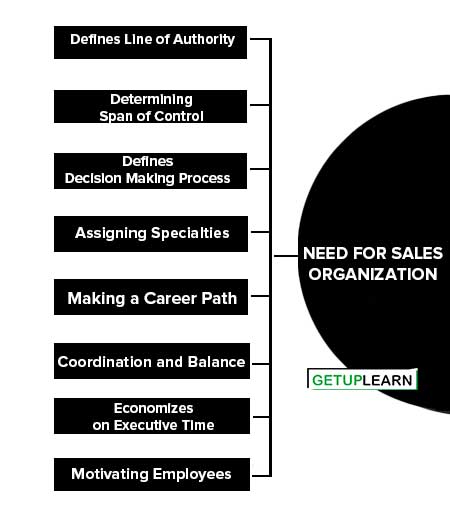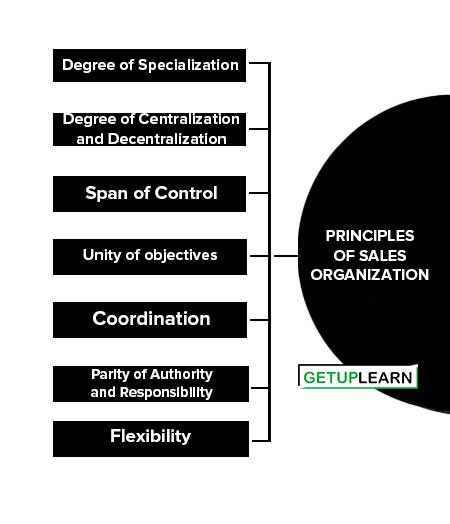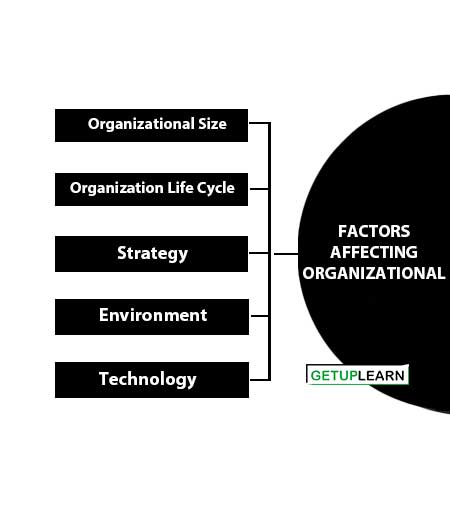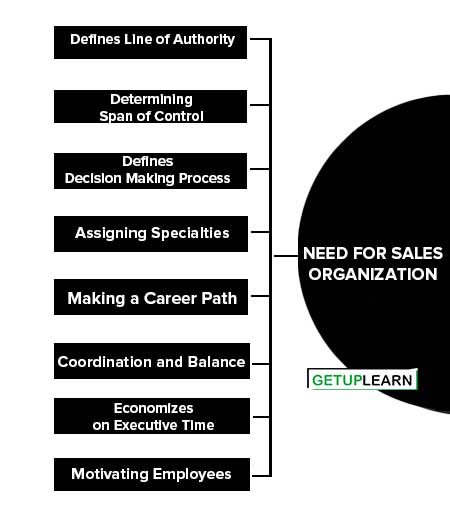Table of Contents
What is Sales Organization?
Organizing is the process by which managers establish the structure of working relationships among employees to allow them to achieve stated organizational goals or objectives efficiently and effectively. It is the job of management, to integrate and coordinate all its constituents. An organization is simply an arrangement of activities involving a group of people.
The goal is to arrange these activities so that the people involved can act better together than they can individually. So, we can say that a sales organization is a structural body or an organization of individuals either working together for the marketing of products and services manufactured by an enterprise or for products that are procured by the firm for the purpose of reselling.
The basic types of organizational structures and designs are used to define work relationships between sales personnel and their superiors. The ideal sales organization has built-in adaptability allowing it to respond appropriately in fluid and diverse marketing environments.
Need for Sales Organization
Execution of the sales plan largely depends upon the nature of the sales organization. Sales organizations vary widely over firms because every enterprise has its own objectives, resources, and corporate plans to achieve those objectives.
The structure of the sales organization reflects this diversity. The sales organization is essential for many reasons. The following need for sales organization are:
- Defines Line of Authority
- Determining Span of Control
- Defines Decision Making Process
- Assigning Specialties
- Making a Career Path
- Motivating Employees
- Coordination and Balance
- Economizes on Executive Time

It is important to define and identify the flow of authority, indicate where responsibility lies, and specify who is to be held accountable to whom.
Determining Span of Control
At a time, there may be a large number of employees working in the sales department. It is very important to enforce proper supervision of the sales force. Hence, there is a need for determining which employee is under the control of which manager.
Defines Decision Making Process
Sales organization also helps in identifying who can take the decisions related to the sales and the customer accounts. There are two main ways of assigning the power to make decisions regarding sales and customer accounts. They are centralized decision-making and decentralized decision-making.
Assigning Specialties
A set of activities are put under a role in which the sales representative is expected to specialize in. This is needed to establish a sales routine in the business unit. For an entry-level, middle level and top-level position, the set of activities and specialties are defined by the sales organization.
Making a Career Path
The personnel in the sales department look at the organizational structures as one of the indications of the direction in which their future careers may grow. The sales field has been a remarkable career maker for innumerable people in the past and has even more potential to do so in the time to come.
Motivating Employees
Since the career path is well known to all the employees, they try to work hard and with dedication to reach higher levels according to the organization’s structure. This helps in integrating the individual into the organization.
Coordination and Balance
By clearly delineating formal relations between different positions in the sales department; the sales organization reduces confusion about the individual’s role and responsibility in the organization.
Economizes on Executive Time
As operations and activities in the sales department increase in number and complexity, delegation of authority becomes imperative. A sound organization design allows the effective use of specialization so that executives may spend less time on operations and more on planning.
Principles of Sales Organization
The main principles of a sales organization can be summarized below:
- Degree of Specialization
- Degree of Centralization and Decentralization
- Span of Control
- Unity of objectives
- Coordination
- Parity of Authority and Responsibility
- Flexibility

Degree of Specialization
The degree to which individuals perform some of the required tasks to the exclusion of others is known as the degree of specialization. Individuals can become experts on certain tasks, leading to better performance for the entire organization.
With regard to specialization, the continuum of responsibilities for members of the sales force runs from a generalist at one end to a specialist at the other end. An absolute generalist would be allowed and expected to engage in all types of sales activities for all of the company’s products and to sell to all of the company’s customers.
On the other hand, an absolute specialist would have a much narrower focus and would be restricted to engaging in a limited set of selling activities for only a portion of the company’s products and would be constrained to selling only to a certain group of customers.
Degree of Centralization and Decentralization
One of the key decisions in sales management is related to the degree of centralization or decentralization of the various sales functions.
The degree to which important decisions and tasks are performed at higher levels in the management hierarchy is called centralization in other words, centralization is said to be a process where the concentration of decision-making is in a few hands or the degree of centralization and decentralization will depend upon the amount of authority delegated to the lowest level.
Centralization is the systematic and consistent reservation of authority at central points in the organization. Under centralization, the important and key decisions are taken by the top management, and the other levels are implemented as per the directions of the top level. Authority and responsibility are placed at higher management levels.
Span of Control
It is the number of subordinates who are supervised by each individual manager. Typically this involves assigning 1-10 people to each manager. The optimal span of control at a particular level in the organizational hierarchy will depend on a variety of factors and two managers with similar or identical titles may have different responsibilities with respect to the number and type of salespeople reporting to them.
Unity of objectives
This principle states that within an organization there needs to be a unity of objectives. An organization may have several sales sub-organizations depending on the product and the selling method. Every sales sub-organization has a set of objectives that it wants to achieve for the organization.
Hence there would be several sales objectives within an organization. The principle states that all the objectives of the sales sub-organization must be linked to the main objective of the organization. If the main objective of the organization is to grow at least by 12% every year, then all the objectives of different sales sub-organization have to work to attain the main objective.
Coordination
In an organization, the sales organization structure should provide a framework where it can easily integrate itself into various other departments within the organization. This ensures the timely delivery of products/ services to the customer.
This principle states that if an employee is given a set of tasks to perform, he/she must be given the required level of authority to perform those tasks.
For example, if a pre-sales executive is asked to prepare the company’s competitive advantages presentation for the client to present in the sales meetings, then he/she should be given access to the knowledge management system of the company.
Every company has a Knowledge Management system which is the repository of all the previous projects executed successfully by the company. Hence the authority has to be given that is required for the task to be completed.
Flexibility
This principle states that there can be many external and internal factors that might affect organizational operations. Hence the sales organization structure should be flexible enough to accommodate any required changes in the future.
Factors Affecting Organizational Design
The following 5 factors affecting organizational design are the most common. They are as follows:

Organizational Size
The larger an organization becomes, the more complicated it becomes. If the organization is very small, it may not even have a formal structure. Small organizations are usually organic systems.
Large organizations develop formal structures as tasks are highly specialized and detailed rules and guidelines dictate work procedures. That is the reason larger organizations are often mechanistic.
Organization Life Cycle
Organizations, tend to progress through stages known as a life cycle having four stages: birth, youth, midlife, and maturity. The older the organization and the larger the organization is, the greater the need for more structure, more specialization of tasks, and more set procedures and rules.
Strategy
How an organization is going to position itself in the market in terms of its product is considered its strategy. A company may decide to adopt a differentiation strategy, or it may decide to follow a cost‐leadership strategy. Each of these strategies requires a structure that helps the organization reach its objectives.
Environment
It can be either stable or dynamic. In the former, the customers’ desires are well understood and probably will remain consistent for a relatively long time. In a dynamic environment, the customers’ desires are continuously changing.
Organizations operating in stable external environments find mechanistic structures to be advantageous while those operating in volatile and frequently changing environments are more likely to find an organic structure.
Technology
Advances in technology are the most frequent cause of change in organizations since they generally result in greater efficiency and lower costs for the firm.
New Types of Sales Organization
Recently, increasing globalization and the use of new IT have brought about innovations in organizational architecture. In response to changing demands and new strategic requirements, new organizational forms are emerging.
All represent efforts to become more responsive to customers. The new types of sales organization concepts include:
- Strategic Alliances
- Business-to-Business Network Structure
- Matrix Design
- Product Team Structure
- Team-Based Organizations

Strategic Alliances
A strategic alliance is a formal relationship created with the purpose of joint pursuit of mutual goals. In a strategic alliance, individual organizations share administrative authority, form social links, and accept joint ownership. Such alliances are blurring firms’ boundaries.
They occur between companies and their competitors, governments, and universities. Such partnering often crosses national and cultural boundaries. It commits two or more companies to exchange or share their resources in order to produce and market a product.
Companies form strategic alliances to develop new technologies, enter new markets, and reduce manufacturing costs. Alliances are often the fastest, most efficient way to achieve objectives.
Business-to-Business Network Structure
A business-to-business network structure is a series of global strategic alliances that one or several organizations create with suppliers, manufacturers, and/or distributors to produce and market a product.
Network structures allow an organization to manage its global value chain in order to find new ways to reduce costs and increase the quality of products, without incurring the high costs of hiring managers to complete these tasks.
Matrix Design
When the environment is dynamic, changing rapidly, and uncertainty is high, even a divisional structure may not provide enough flexibility. Matrix design is one of the most flexible types of organizational structures. In a matrix structure, managers group people in two ways simultaneously: By function, and By product.
The result is a complex network of reporting relationships that make the matrix structure very flexible. Each person in a product team reports to two bosses: a functional boss, who assigns individuals to a team and evaluates performance, and the boss of the product team, who evaluates their performance on the team.
Teams are empowered and team members are responsible for making important decisions, to keep the matrix structure flexible. Matrix structures have been successfully used for years at high-tech companies where new product development takes place frequently and the need to innovate quickly is vital to the organization’s survival.
Product Team Structure
The dual reporting relationships of a matrix structure have always been difficult for managers and employees to deal with. To avoid these problems, managers have devised another way of organizing people and resources in the form of a product team structure.
The product team structure differs from a matrix in that: It does away with dual reporting relationships and two-boss managers, and Functional employees are permanently assigned to a cross-functional team. In this, a group of managers brought together from different departments to perform organizational tasks.
They report only to the product team manager. Increasingly, organizations are making empowered teams an essential part of their organizational architecture to help them gain a competitive advantage in fast-changing organizational environments.
Team-Based Organizations
Many organizations are more responsive to their environment because they use work teams as their basic building blocks; that is they are team-based organizations. Teams are made of different functional units, such as manufacturing, technical support, marketing, and sales.
These cross-functional teams are composed of a defined group of individuals bringing together expertise from different parts of the supplier organization to capture, retain, and increase business with customers. Cross-functional teams operate separately from traditional, vertical lines of authority.
Moreover, cross-functional teams often are short-lived. Teams form, complete their tasks, disband, and then new teams form. People may be members of more than one cross-functional team simultaneously.
FAQs About the Sales Organization
What is the need for a sales organization?
The need for a sales organization are:
1. Defines Line of Authority
2. Determining Span of Control
3. Defines Decision Making Process
4. Assigning Specialties
5. Making a Career Path
6. Motivating Employees
7. Coordination and Balance
8. Economizes on Executive Time.
